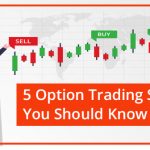Margin money plays a vital role in futures trading as it is that it authorizes to leverage. In comparison to spot market transaction, margins are the ones that allow ‘Futures agreement’. You might know that futures are an improvement over forwards. Actually, the futures agreement inherits the transactional layout of the forwards market. Before we proceed we need to clear our concept on future trading.
Characteristics of future market
1. In terms of the spot market, the futures price imitate the primary price. In fact, the futures price and spot prices are completely different.
2. All futures contract are the standard contract with pre-set agreements. These are in terms of lot size and expiry date. The minimum quantity specified in the futures contract is exactly the lot size.
Contract value = Futures Price * Lot Size
3. You can hold the futures agreement up to a certain time. The last day on which you can hold is the expiry date,
4. To begin with futures agreement, the investors will have to deposit margin money. Your broker calculates it at a certain percentage of the contract value. Therefore, the margin money allows investors to deposit a small amount. Then they can take wider exposure to value transaction, thereby leveraging on the transaction.
5. Before you operate in a futures contract, you have to digitally sign the agreement with the counterparty. This constrains you to honour the contract upon expiry.
6. The agreement in futures is tradable. This indicates that you do not need to hold on to the agreement until the expiry. If the movement of the price is in your favour then you can hold and can get financial gains. For example, let’s assume an investor who buys Infosys Futures at 9:15 AM at a price of 1951 and sell it by 9:17 AM in 1953. Since Infosys lot size at the time was 250, our investor would stand to make INR 500 (2 * 250) within a matter of 2 minutes. Our investors further have a choice of holding it overnight for a few days or even can hold it till expiry.
7. In futures, there is a term called “Zero Sum Game” which means this Instrument allows the investor to transfer money from one pocket to another. The higher the leverage, maximum is the risk. The payoff structure of a futures instrument is linear.
Difference between future and forward contracts
The following table makes a clear distinction on future and forwards contracts in India –
|
Base
|
Futures Contract
|
Forwards Contract
|
|
Nature
|
Traded on an organized exchange
|
Traded on Over-the-Counter
|
|
Contract Terms
|
Contracts are standardized by the exchange
|
Contracts are customised by the participants
|
|
Liquidity
|
Highly liquid
|
Low liquidity
|
|
Margin Payments
|
Requires margin payments
|
No margin is required
|
|
Settlement
|
All future contracts mandatorily follow the daily settlement
|
Forwards generally settles at the end of the expiration period
|
|
Squaring off
|
It is possible to revise the contract by any member of the exchange
|
A contract can only be reversed by the same counter-party with whom it was entered into
|
Let’s now focus more on the concept of margins and mark-to-market, in the following section.
What is the margin money?
The margin money indicates the amount of the equity, the investor has in their brokerage account. The concept of “to margin” or “to buy on margin money” means to use the money borrowed from the broker to purchase securities. Therefore, in simple words, the margin account is a brokerage account in which the broker lends the investors money to buy more securities. They can buy more as compared to the actual purchasing as per their account.
For example, if you have an initial margin money requirement of 70% for your margin account. You want to purchase INR 10,000 worth of securities, then your margin would be INR 7,000, and you could borrow the rest from the broker.
Why your broker collects margin money?
To explain the collection of margin money, we should now consider an example in the forward market. Suppose in 3 months from now ABC Jewellers agrees to buy 15 Kgs of Gold at INR.2450 per gram from XYZ Gold Dealers.
As we all know that any variation in the price of gold will either affect ABC or XYZ negatively. XYZ suffers a loss if in case the price of gold increases and ABC makes a profit. Similarly, when the price of gold decreases ABC suffers a loss and XYZ makes a profit. Also, a forwards agreement works on a gentleman’s word. Here, let’s take a situation into consideration, where the price of gold has excessively risen up putting XYZ Gold Dealers in a difficult spot. Therefore, XYZ can say they cannot make the necessary payment and thereby default on the deal occurs. Obviously what follows will be a long and gruelling legal chase. Hence this is outside our focus area. The important consideration here is that in a forwards agreement the scope to default is very high.
Since the futures market is an improvement over the forward market, there are negligible chances of default. Hence, here the margins come into action and play a vital role.
If we talk about the forwards market then there is no regulator. The agreement between the two parties takes place with strictly no intermediary watching over their transaction. However, all the trades route through an exchange in the futures market. There is always a burden of guaranteeing the settlement of all the trades exchange in return. The ‘obligation of guaranteeing’ simply means the exchange making sure the trader gets their money if there is an entitlement. This ensures that they collect the money from the party who needs to pay up. Thus,
” The exchange make sure this works seamlessly by –
Collecting the margin money
Marking the daily profits or losses to market (also called M2M) ”
Explain the concept of initial margin, span margin, and exposure margin
The concept of Margin and Mark to Margin is something that the traders need to know in corresponding to thoroughly acknowledge the dynamics of futures trading. Although, it is a bit complicated to understand both the concepts at the same time. So, here I would like to pause a bit on margin money and proceed to Mark to Margin. We will understand Mark to Margin completely and come back again to margins. We will then relook at margins keeping Mark to Margin in perspective. But before we move to Mark to Margin, I would like you to keep the following points in the back of your mind.
Step-by-step working of margin money-
- The broker blocks the margins in the trader’s trading account when it comes up to initiate the futures position.
- The term that can be used in terms of blocking the margins is the “Initial Margin”
- The initial margin has two sub-parts i.e., SPAN margin and the Exposure Margin
- Initial Margin = SPAN Margin + Exposure Margin
- Your broker will block Initial Margin in your trading account for the days one chooses to hold on to the futures trade. There will always be a variation in the value of the initial margin on a daily basis as it has a dependency on the futures price.
“Remember, Initial Margin = % of Contract Value
Contract Value = Futures Price * Lot Size”
6. The lot size does not change whereas there is a variation in futures price on a daily basis. This means the margins also vary every day
What are mark-to-margin?
Mark to margin is an evaluation of the fair value of future accounts. This can change along with time in terms of assets and liabilities. The only focus of mark-to-market is to provide a realistic appraisal of a company’s or an institution’s current financial situation.
There is always a fluctuation in futures price on a daily basis. Thus, by virtue of which the trader tends to either stand to make a profit or bear a loss. Marking to market, or mark-to-market (M2M) is an easy accounting procedure that involves adjusting the profit or loss you have made for the day and authorizing the same. Mark-to-margin is applicable depending upon the trader holds the futures contract. For example:
Assume on 1st April 2019 at around 12:00 AM, you decide to buy Infosys Futures at INR 749.90. The Lot size is 1200. Three days later on 3rd April 2019, you decide to square off the position at 01:15 PM at INR 751.60. As per the calculation below shows, this is a profitable trade –
Buy Price = INR. 749.90
Sell Price = INR. 751.60
Profit per share = INR (751.60 – 749.90) = INR 1.7
Total Profit = 1200 * 1.7 = INR 2040
However, the trade was held for 3 working days. Depending on the holding of the futures contract, the profits or loss is marked to market. Wherein marking to market, the closing price of the previous day is taken as the reference rate to do the calculation of the profit or losses.
| Day |
Closing Price |
| 1st April 2019 |
749.90 |
| 2nd April 2019 |
750.10 |
| 3rd April 2019 |
751.60 |
In the table above shown gives the scenario of the futures price movement over the 3 days the contract was held.
Can you explain M2M with an example?
Let us continue with the above example to clear the understanding of how M2M works on a day-to-day basis.
On Day 1 at 11:30 AM you purchase the Infy futures at INR 749.90. The contract went up further to close at INR 750. Hence profit for the day is INR 750 minus INR 749.90 = INR 0.10 per share. The net profit on one lot for the day is 0.10*1200 = INR 120. Hence, the exchange ensures (via the broker) that INR 120 is put to your trading account at the end of the day.
On day 2, the futures closed at INR 751.50. The profit earned for the day would be INR 751.50 minus INR 750 i.e. INR 1.50 per share or INR 1800. This profits also go to your account after the day closing.
On day 3, the futures closed at INR 750.90 which means there is a loss to the extent of – INR 720 ((751.50 – 750.90) * 1200 ). The loss amount will be automatically debited from your trading account.
Now, let us just tabulate the value of the daily mark to market and see how much money has come in and how much money has gone out –
| Day |
Ref Price for M2M |
Closing Price |
Daily M2M |
| 1st April 2019 |
749.90 |
750.00 |
+ INR 120 |
| 2nd April 2019 |
750.00 |
751.50 |
+ INR 1800 |
| 3rd April 2019 |
751.50 |
750.90 |
– INR 720 |
| Total |
+ INR 1200 |
Well, if you summed up all the M2M cash flow you will end up with the same amount, which is –
Buy Price = INR 749.90
Sell Price = INR 750.90
Profit per share = INR (750.90 – 749.90 ) = INR 1.00
Total profit per lot = 1200 * 1.00 = INR 1200
” Therefore, the mark-to-market refers to a daily adjustment of accounting wherein –
1. There will be either credit or debit from your account.
2. The previous day close price acts as the base to calculate the present day M2M “
Discuss the importance of margin in trading from the retail investor perspective
Initial margin is a certain percentage of the contract value. We also know –
Initial Margin (IM) = SPAN Margin + Exposure Margin
The number of times a trader initiates futures, there are intermediaries to make trading moves smoothly. The two foremost financial intermediaries in the trading process are the broker and the exchange.
Considering a situation wherein, the client defaults on an obligation, then it has a financial fall out on both the broker and the exchange. Hence margin money insulates both the financial intermediaries against any possible client default.
In fact, this is exactly how it works. ‘SPAN Margin’ is the mandatory margins. The exchanges block it as per the exchange’s mandate. Your broker blocks amount for exposure margin over and above the span margin to cushion for any MTM losses. The exchange identifies both the span and exposure margin. So at the time of initiating a futures trade, the client has to adhere to the initial margin requirement. The exchange block the complete initial margin (SPAN + Exposure).
Amongst the two margins, SPAN Margin is more important. As it is that it does not have a penalty from the exchange in the account. As long as you wish to carry your position, your broker will strictly maintain the span margin. It is therefore also called maintenance margin.
The variation of the contract value is in between 4% – 5% for exposure margin that is usually an additional margin.
Worried about margin? No worries. Calculate the margin requirement even before initiating your trade with the National Stock Exchange calculator for margin.
About Author

Stock Trading Now trade in ₹9 Per Order or ₹ 999 Per Month Plans.
Future & Options Access F&O contracts with advanced tools for hedging and speculation.
Currency Trading Trade in major currency pairs and manage forex exposure efficiently.
Commodity Trading Diversify Trading with MCX & NCDEX by Trading in Gold, Silver, Base Metals, Energy, and Agri Products.
Margin Trading Funding Boost your buying power with upto 5X, Buy now Pay Later
Algo Trading Back test, Paper Trade your logic & Automate your strategies with low-latency APIs.
Trading View Leverage Trading View charts and indicators integrated into your trading platform.
Advanced Options Trading Execute multi-leg option strategies with precision and insights.
Stock Lending & Borrowing Earn passive income by lending stocks securely through SLB.
Foreign Portfolio Investment Enable NRIs and FPIs to invest in Indian markets with ease and compliance.
IPO Invest in upcoming IPOs online with real-time tracking and instant allotment updates.
Direct Mutual Funds 0% Commissions by investing in more than +3500 Direct Mutual Fund Scheme.
Corporate FDRs Earn fixed returns with low-risk investments in high-rated corporate fixed deposits.
Stocks SIPs Build long-term wealth with systematic investment plans in top-performing stocks.
Bonds & NCDs Access secure, fixed-income investments through government and corporate bond offerings.
Depository Services Safely hold and manage your securities with seamless Demat and DP services with CDSL.
Journey Tracing our growth and milestones over time.
Mission & Vision Guided by purpose, driven by long-term vision.
Why RMoney Platform Smart, reliable platform for all investors' needs.
Management Experienced leadership driving strategic financial excellence.
Credentials Certified expertise with trusted industry recognition.
Press Release Latest company news, updates, and announcements.
Testimonials Real client stories sharing their success journeys.
7 Reasons to Invest Top benefits that make investing with us smart.
SEBI Registered Research Trusted insights backed by SEBI-compliant research.
Our Technology Advanced tools enabling efficient online trading.
Calculators Access a suite of smart tools to plan trades, margins, and returns effectively.
Margin Calculator Instantly check margin requirements for intraday and delivery trades.
MTF Calculator Calculate MTF funding cost upfront to ensure full transparency before placing a trade.
Brokerage Calculator Know your exact brokerage charges before placing any trade.
Market Place Explore curated investment products and trading tools in one convenient hub.
RMoney Gyan Enhance your market knowledge with expert blogs, videos, and tutorials.
Performance Tracker Track our research performance with full transparency using our performance tracker.
Feedback Share your suggestions or concerns to help us improve your experience.
Downloads Access important forms, software, and documents in one place.
Locate Us Find the nearest RMoney branch or service center quickly.
Escalation Matrix Resolve issues faster with our structured support escalation process.
Back Office Log in to view trade reports, ledger, and portfolio statements anytime.
Account Modification Update personal or bank details linked to your trading account.
Fund Transfer Transfer funds instantly online with quick limit updation to your trading account.
Bank Details View our registered bank account details for seamless transactions by NEFT, RTGS or IMPS.
How to Apply IPO Step-by-step guide to apply for IPOs using your trading account.
RMoney Quick Mobile App Trade on-the-go with our all-in-one mobile trading app.
RMoney Quick login Quickly access your trading account through the RMoney Quick web-based trading.
RMoney Rocket Web Version Experience powerful web-based trading with advanced tools for algo traders.
RMoney Rocket Mobile Version Trade anytime, anywhere with our feature-rich mobile trading platform.




















